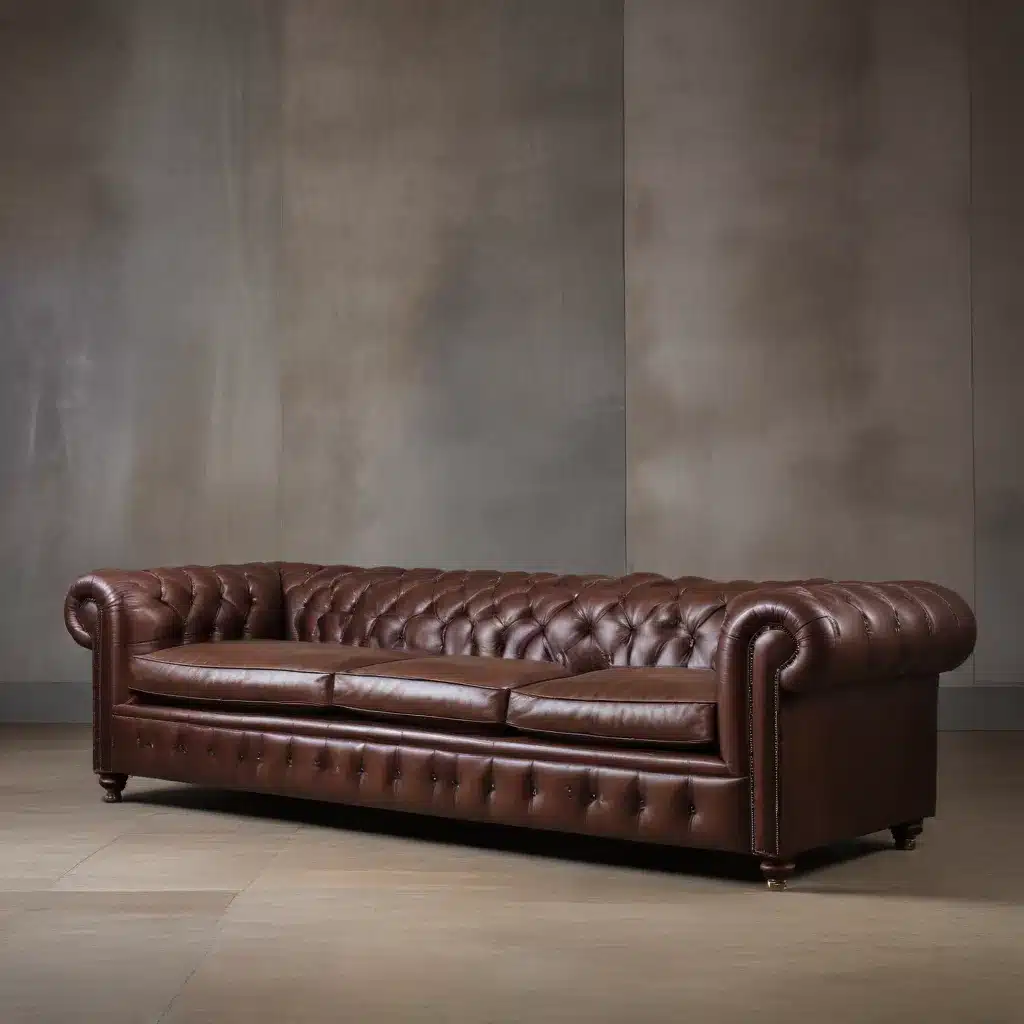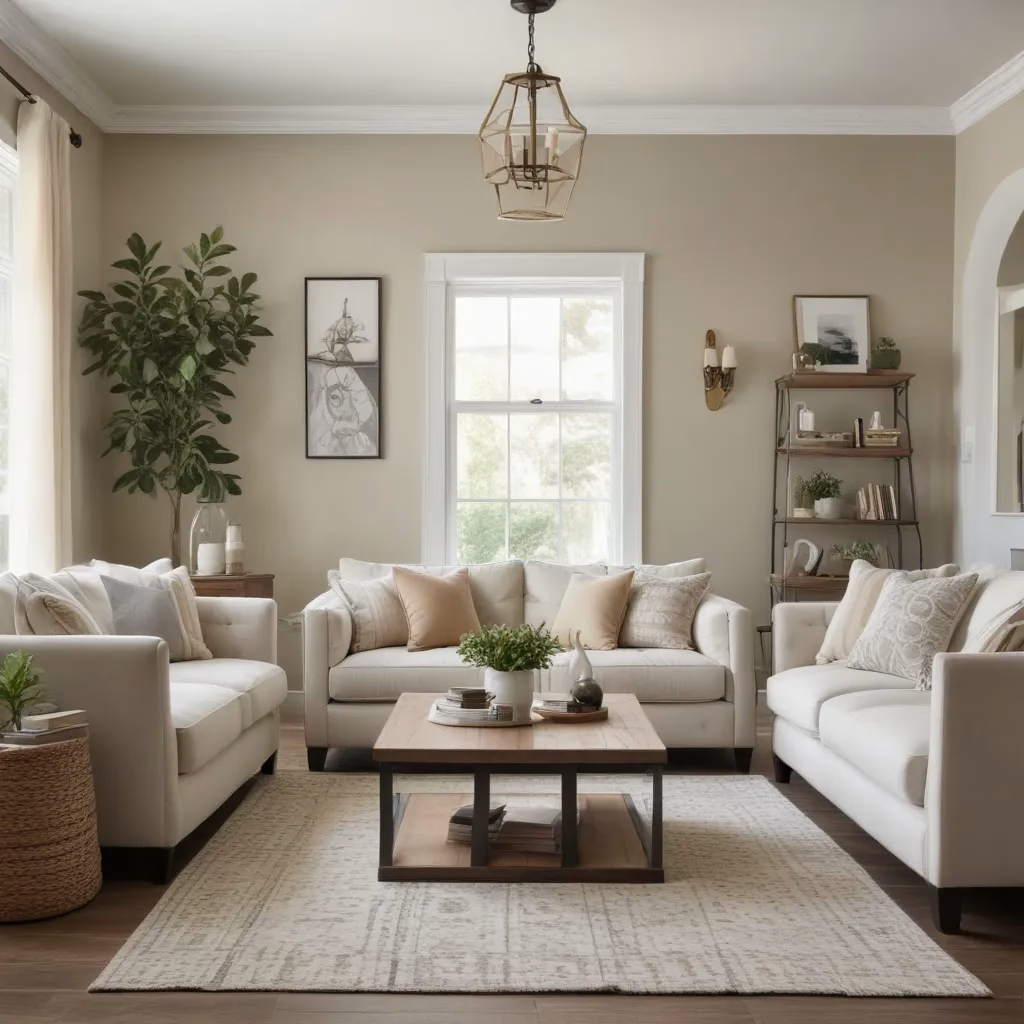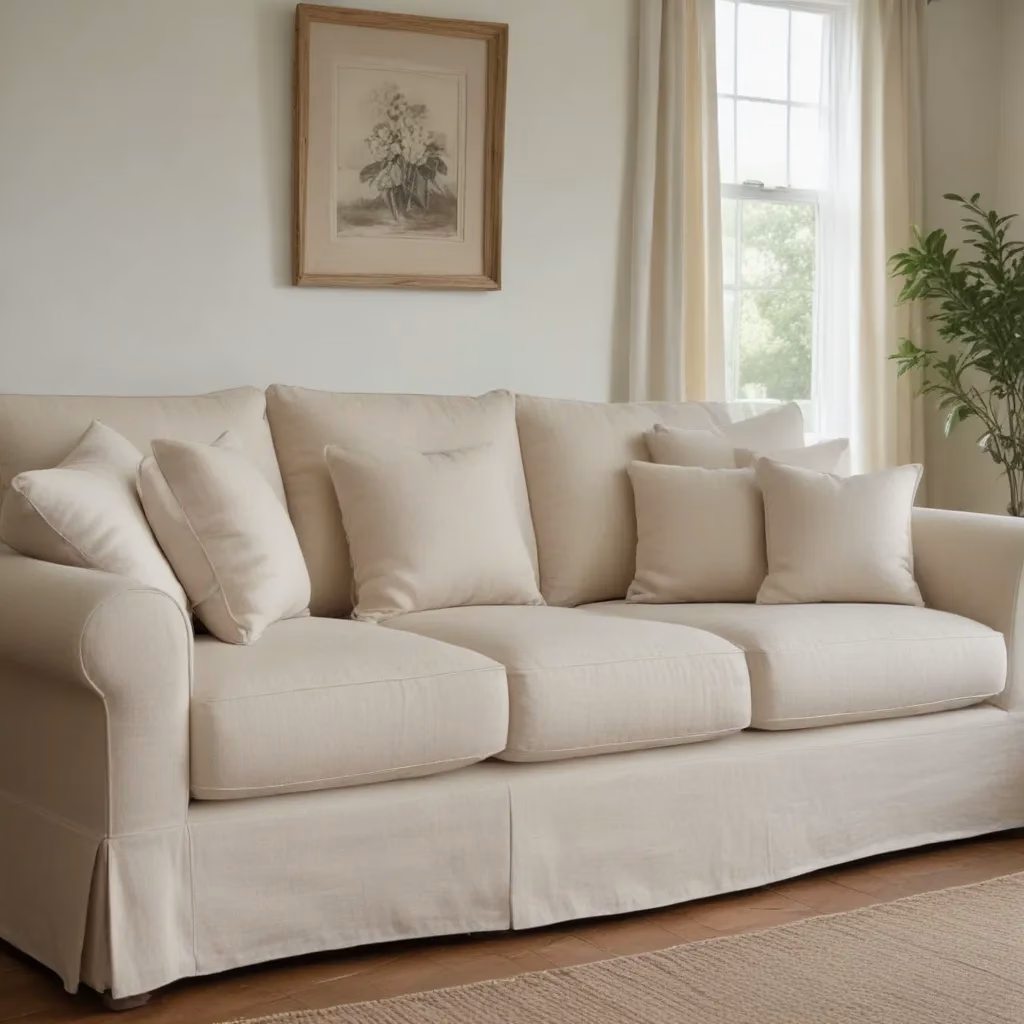
As a furniture specialist with over two decades of experience in the industry, I’ve witnessed countless trends come and go. However, some classics never truly fade away – they simply evolve. The Chesterfield sofa is one such icon that has stood the test of time, reinventing itself for the modern era while maintaining its timeless appeal.
The Enduring Legacy of the Chesterfield
The Chesterfield sofa has been a symbol of luxury and sophistication for centuries. Its distinctive deep-buttoned upholstery, rolled arms, and equal back and arm height have made it instantly recognizable. But what makes this classic piece so adaptable to contemporary interiors?
From my experience working with both traditional and modern homes, I’ve found that the Chesterfield’s versatility lies in its strong silhouette. This allows it to serve as an anchor piece in various design schemes, from classic to avant-garde. The key to its longevity is its ability to blend seamlessly with different aesthetics while retaining its characteristic charm.
Over the years, I’ve seen homeowners and designers alike gravitate towards the Chesterfield for its ability to add a touch of elegance to any space. Whether placed in a grand living room or a cozy study, this sofa commands attention and respect.
Contemporary Twists on a Classic Design
In recent years, I’ve noticed a surge in demand for updated versions of the Chesterfield. Manufacturers and designers have taken the core elements of this iconic sofa and reimagined them for modern living. Here are some of the exciting trends I’ve observed:
Sleeker Profiles
Gone are the days when Chesterfields were solely associated with bulky, overstuffed forms. Today’s versions often feature slimmer profiles and more streamlined silhouettes. I’ve worked with clients who’ve opted for Chesterfields with thinner arms and less pronounced tufting, creating a more minimalist look that fits perfectly in contemporary spaces.
Bold Color Choices
While the traditional leather Chesterfield in rich brown or black will always have its place, I’ve seen a marked increase in the use of vibrant colors and unexpected fabrics. From jewel-toned velvets to pastel linens, these new iterations bring a fresh energy to the classic form.
Mixed Materials
One of the most exciting developments I’ve encountered is the incorporation of mixed materials in Chesterfield designs. I’ve advised clients on selecting pieces that combine leather upholstery with wooden or metal frames, creating an interesting juxtaposition of textures and finishes.
Choosing the Right Contemporary Chesterfield
When helping clients select a modern Chesterfield, I always stress the importance of considering both form and function. Here are some key factors to keep in mind:
Scale and Proportion
The size of your Chesterfield should be in proportion to your room. I often recommend taking measurements and using painter’s tape to outline the sofa’s footprint on the floor. This helps visualize how it will fit in the space.
Comfort Level
While traditional Chesterfields can be quite firm, many contemporary versions offer enhanced comfort. I’ve found that sofas with a mix of foam and down filling provide a good balance of support and softness.
Upholstery Material
The choice of upholstery can dramatically affect both the look and maintenance of your Chesterfield. For high-traffic areas, I often suggest performance fabrics that resist stains and wear. For more formal settings, a luxurious velvet or leather can elevate the entire room.
Styling Your Contemporary Chesterfield
Once you’ve selected your perfect Chesterfield, the fun part begins – styling it within your space. Here are some tips I often share with my clients:
Contrasting Elements
To prevent your room from feeling too traditional, pair your Chesterfield with more modern pieces. I’ve seen stunning results when combining a classic tufted sofa with sleek metal side tables or abstract art.
Textural Layering
Add depth to your seating area by layering textures. Toss pillows in various fabrics and throw blankets can soften the structured lines of a Chesterfield.
Lighting Considerations
The right lighting can enhance the beauty of your Chesterfield. I often recommend placing a floor lamp behind the sofa to highlight its silhouette, or flanking it with table lamps for a balanced look.
Maintaining Your Contemporary Chesterfield
Proper care is essential to ensure your Chesterfield remains a centerpiece for years to come. Based on my experience, here are some maintenance tips:
Regular Cleaning
Vacuum your Chesterfield weekly to prevent dust and debris from settling into the tufting. For leather upholstery, wipe down with a slightly damp cloth periodically.
Professional Care
I advise my clients to have their Chesterfields professionally cleaned at least once a year. This helps maintain the integrity of the upholstery and extends the life of the sofa.
Addressing Wear and Tear
Pay attention to high-wear areas like armrests and seat cushions. Rotate cushions regularly if possible, and consider using arm covers in high-traffic households.
The Future of the Chesterfield
As we look ahead, I’m excited about the continued evolution of this classic design. I’ve been following developments in sustainable materials and modular designs that promise to make the Chesterfield even more versatile and eco-friendly.
One trend I’m particularly enthusiastic about is the integration of smart technology into furniture design. Imagine a Chesterfield with built-in charging ports or adjustable lumbar support – the possibilities are endless!
Incorporating a Contemporary Chesterfield in Different Room Types
Throughout my career, I’ve had the pleasure of working with clients to integrate Chesterfields into various spaces within their homes. Let’s explore how this versatile piece can enhance different room types:
Living Room
In the living room, a Chesterfield can serve as the focal point around which the entire design scheme revolves. I often suggest placing it centrally, facing a fireplace or entertainment unit. To balance its substantial presence, I recommend pairing it with lighter, more streamlined pieces like glass coffee tables or slender armchairs.
Home Office
A smaller Chesterfield or Chesterfield-inspired office chair can add a touch of sophistication to a home office. I’ve found that this works particularly well in spaces that blend traditional and modern elements. The key is to choose a scale appropriate for the room – you don’t want the sofa to overwhelm the workspace.
Bedroom
For larger bedrooms, a Chesterfield at the foot of the bed can create a luxurious seating area. I often advise clients to opt for lighter colors in bedroom Chesterfields to maintain a restful atmosphere. Pairing it with plush area rugs and soft lighting can create a cozy reading nook.
Entryway
In spacious entryways, a small Chesterfield can provide both functionality and style. It offers a place to sit while putting on shoes and creates an inviting first impression. I typically suggest choosing a more compact version in durable fabric to withstand the wear and tear of a high-traffic area.
Color Trends in Contemporary Chesterfields
Color choice can dramatically impact how a Chesterfield fits into your decor. Here are some current color trends I’ve observed:
Neutral Tones
Greys, beiges, and whites remain popular choices for those seeking versatility. These neutral tones allow the Chesterfield’s form to shine without overwhelming the color scheme of the room.
Rich Jewel Tones
Deep emerald greens, sapphire blues, and ruby reds are making a strong statement in contemporary interiors. These bold colors can turn a Chesterfield into a true conversation piece.
Pastel Hues
For a softer look, pastel-colored Chesterfields in blush pink, mint green, or light blue can add a touch of whimsy to a room while maintaining an air of sophistication.
Customization Options for Contemporary Chesterfields
One of the most exciting aspects of modern furniture design is the level of customization available. When working with clients on selecting a Chesterfield, I often discuss the following options:
Button Design
While deep buttoning is a hallmark of the Chesterfield, contemporary versions offer variations. Some feature shallower tufting, while others experiment with button size and spacing for a unique look.
Leg Styles
The legs of a Chesterfield can significantly impact its overall appearance. Options range from traditional turned wood legs to sleek metal hairpin legs for a more modern touch.
Back Height
Variations in back height can change the entire profile of a Chesterfield. Lower backs tend to look more contemporary, while higher backs maintain a more traditional silhouette.
Chesterfields in Commercial Spaces
My work isn’t limited to residential interiors – I’ve also had the opportunity to incorporate Chesterfields into various commercial spaces. Here’s how these iconic sofas can enhance different business environments:
Hotel Lobbies
In hotel lobbies, Chesterfields add an air of luxury and comfort. I often recommend grouping them to create intimate seating areas where guests can relax or conduct informal meetings.
Restaurants and Bars
Chesterfield booths or banquettes can bring a touch of old-world charm to dining establishments. In bars, leather Chesterfields create a cozy, club-like atmosphere that encourages patrons to linger.
Corporate Offices
In corporate settings, Chesterfields in reception areas or executive offices convey a sense of established success and sophistication. I’ve found that they work particularly well in law firms and financial institutions.
The Environmental Aspect of Contemporary Chesterfields
As sustainability becomes an increasingly important consideration in furniture design, I’ve been pleased to see many manufacturers taking steps to make Chesterfields more eco-friendly. Here are some developments I’ve been following:
Sustainable Materials
Some companies are now offering Chesterfields upholstered in recycled fabrics or leather alternatives made from plant-based materials. These options allow environmentally conscious consumers to enjoy the classic design without compromising their values.
Longevity and Repairability
One of the most sustainable aspects of a well-made Chesterfield is its longevity. I always advise clients to invest in quality pieces that can be repaired and reupholstered rather than replaced. Many contemporary Chesterfields are designed with this in mind, featuring removable covers and repairable frames.
Local Production
To reduce carbon footprint, some manufacturers are focusing on local production. I’ve had positive experiences working with companies that source materials and produce their Chesterfields within the same region, supporting local economies and reducing transportation emissions.
Mixing Chesterfields with Other Furniture Styles
One of the joys of working with Chesterfields is their ability to complement a wide range of furniture styles. Here are some successful combinations I’ve implemented in client homes:
Chesterfield and Mid-Century Modern
The clean lines of mid-century modern furniture can provide a striking contrast to the ornate detailing of a Chesterfield. I’ve paired leather Chesterfields with walnut credenzas and Eames chairs to great effect.
Chesterfield and Industrial
The plush comfort of a Chesterfield sofa can soften the hard edges of industrial-style furniture. In loft spaces, I’ve combined velvet Chesterfields with metal and wood pieces for an eclectic, lived-in look.
Chesterfield and Scandinavian
The simplicity of Scandinavian design can balance the grandeur of a Chesterfield. I often suggest pairing a neutral-colored Chesterfield with light wood furniture and minimalist decor for a harmonious blend of styles.
The Role of Chesterfields in Biophilic Design
Biophilic design, which seeks to connect building occupants more closely to nature, has gained popularity in recent years. While Chesterfields might not seem an obvious choice for this style, I’ve found creative ways to incorporate them:
Natural Materials
Choosing Chesterfields upholstered in natural fibers like wool or cotton can help them blend with biophilic design principles. I’ve also worked with manufacturers who offer options with exposed wood frames, bringing an element of nature into the design.
Color Harmony
Selecting Chesterfields in colors that complement natural elements in the room – such as plants or stone features – can create a cohesive biophilic space. Earth tones and greens work particularly well in these settings.
Placement
Positioning a Chesterfield near large windows or in sunrooms can help blur the lines between indoor and outdoor spaces, a key principle of biophilic design.
The Psychology of Chesterfields in Interior Design
As a furniture specialist, I’m fascinated by the psychological impact of different pieces on a space. Chesterfields, with their rich history and distinctive appearance, can have a powerful effect on how people perceive and use a room:
Creating a Sense of Security
The high backs and arms of traditional Chesterfields can create a feeling of enclosure and safety. In open-plan spaces, I often use Chesterfields to carve out cozy nooks that feel separate from the larger area.
Encouraging Social Interaction
The curved shape of many Chesterfields naturally encourages face-to-face conversation. In living rooms and public spaces, I frequently arrange Chesterfields in a way that facilitates social interaction.
Conveying Status and Sophistication
The association of Chesterfields with luxury and refinement can elevate the perceived status of a space. In professional environments, I’ve used Chesterfields to create an impression of established success and attention to detail.
Conclusion: The Timeless Appeal of the Contemporary Chesterfield
As we’ve explored throughout this article, the Chesterfield sofa continues to be a versatile and beloved piece of furniture, adapting to contemporary tastes while retaining its classic charm. Its ability to bridge the gap between traditional and modern design makes it a valuable addition to a wide range of interiors.
From my years of experience in the furniture industry, I can confidently say that the Chesterfield is more than just a sofa – it’s a design statement, a conversation starter, and a piece of history reimagined for modern living. Whether you’re furnishing a cozy apartment or a grand mansion, there’s a contemporary Chesterfield that can elevate your space.
As you consider incorporating a Chesterfield into your home or commercial space, remember that quality and craftsmanship are key. A well-made Chesterfield is an investment that can last for generations, adapting to changing styles and needs over time.
For more inspiration and expert advice on selecting the perfect Chesterfield for your space, I recommend visiting Sofa Spectacular. Their curated collection showcases the best in contemporary Chesterfield design, helping you find the ideal piece to make your interior truly spectacular.



